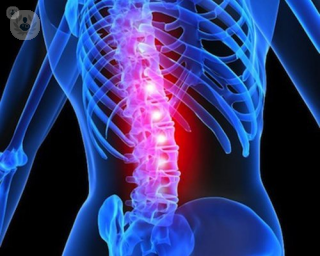Cervical spine pain
Dr Zbigniew Kirkor - Pain medicine
Created on: 09-12-2022
Updated on: 11-27-2023
Edited by: Conor Dunworth
What is the cervical spine?
The cervical spine, also known as the neck region, is a part of the spinal column or backbone. It is made up of seven vertebrae (small spinal bones) in the neck, as well as intervertebral discs, ligaments, tendons and muscles.

What causes cervical spine pain?
Cervical spine pain, or neck pain, can be caused by a number of different factors. One of the most common causes of cervical spine pain is the natural wear and tear of the cervical vertebrae and cartilage in the neck as we age.
Another common cause is a cervical herniated disc. In between the seven vertebrae that make up the cervical spine, there are a number of spongy discs that act as shock absorbers in the body. These discs can sometimes bulge or slip out of their correct position between the vertebrae, causing severe pain. The discs can also break down in a condition known as a degenerative disc disease.
Cervical spine pain can also be caused by spinal stenosis. This occurs when the space in between the back bone is too small, which puts pressure on the spinal cord and the nerves the spine protects. This can damage the spinal cord, leading to a condition known as cervical spinal myelopathy.
Cervical spine pain can also be caused by injury to the spine or neck, poor posture, obesity, trapped or compressed nerves or other medical conditions such as arthritis, cancer or meningitis.
How is cervical spine pain diagnosed?
Your neck pain will usually be diagnosed by a doctor giving you a physical exam, while also taking into account your medical history.
The physical exam will usually involve checking your muscle strength and reflexes, and moving your neck to locate the pain and see if there are motion problems.
An x-ray, MRI or CT scan may also be used to diagnose your neck pain. These scans can see if there is any damage to the cervical vertebrae, the tissues surrounding them or the nerves in the cervical spine.

How can cervical spine pain be prevented?
There are a number of measures you can take to prevent cervical spine pain. Increasing your core strength and flexibility through exercise can help prevent neck pain. Losing weight if you are obese can also help prevent pain, as extra weight can put pressure on the vertebrae.
Correct posture when sitting at your desk and throughout the day are also important. It is also very important to always lift heavy objects with the support of your legs, so as not to strain your back.
How is cervical spine pain treated?
There are a number of treatments available to for cervical spine pain.
One of the latest treatments is Regenexx ®. This is a non-surgical regenerative treatment that can help patients manage pain. It is a treatment that uses your own body's stem cells and platelets to fight degenerative diseases such as arthritis. Only highly-trained specialists are qualified to provide this treatment, meaning patients are usually very satisfied with the results of Regenexx® treatments.
Surgery is another treatment option for cervical spine pain; however, this is a much more invasive procedure than Regenexx®. Surgery can free compressed nerves, or repair damaged spinal discs.
Physical therapy is another option. A physiotherapist can help you to stretch and strengthen muscles, tendons and ligaments in the neck, which can help to ease pain. This is sometimes sufficient in treating cervical spine pain.
Can cervical spine pain be treated using home remedies?
Yes. There are a number of measures that patients can take to help relieve their pain. Using ice or heat packs, gentle stretches and painkillers such as paracetamol and ibuprofen can help treat moderate cervical spine pain.

Which specialist treats cervical spine pain?
Orthopaedic surgeons usually treat cervical spine if it is severe and requires surgery, as well as any other musculoskeletal pain. Pain medicine specialists also treat the condition. Milder cervical spine pain is also treated by physiotherapists.


